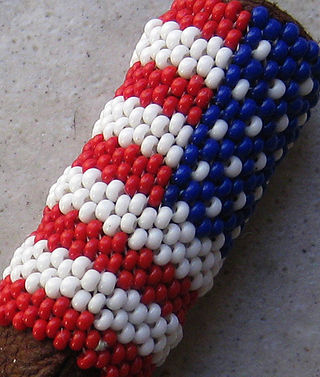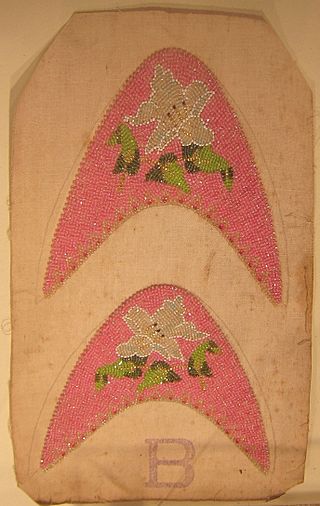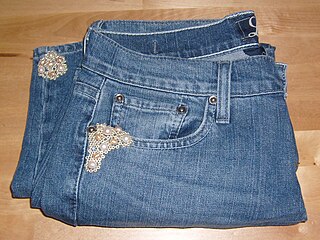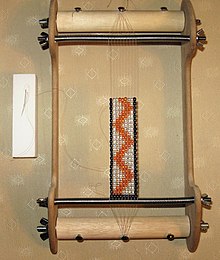
A bead is a small, decorative object that is formed in a variety of shapes and sizes of a material such as stone, bone, shell, glass, plastic, wood, or pearl and with a small hole for threading or stringing. Beads range in size from under 1 millimetre (0.039 in) to over 1 centimetre (0.39 in) in diameter.

Jewellery consists of decorative items worn for personal adornment, such as brooches, rings, necklaces, earrings, pendants, bracelets, and cufflinks. Jewellery may be attached to the body or the clothes. From a western perspective, the term is restricted to durable ornaments, excluding flowers for example. For many centuries metal such as gold often combined with gemstones, has been the normal material for jewellery, but other materials such as glass, shells and other plant materials may be used.

The peyote stitch, also known as the gourd stitch, is an off-loom bead weaving technique. Peyote stitch may be worked with either an even or an odd number of beads per row. Both even and odd count peyote pieces can be woven as flat strips, in a flat round shape, or as a tube. Tubular peyote is used to make pouches or to decorate objects such as bottles or fan handles.

A hair drop is an ornament worn by men from Great Lakes and Plains tribes. It would be tied to the man's hair. The typical example consists of a quilled or beaded section on a strip of leather, which was later attached to an American buffalo tail. They could be over two feet long.

Peranakan beaded slippers, also known as Kasut Manik, literally meaning "beaded shoes", is a type of shoe that dates back to the early twentieth century Malaya. It refers to beaded slippers worn by a nyonya to complete her Sarong Kebaya outfit, together with chained brooches (kerosang) and a silver belt. The slippers are made of Peranakan cut beads, which are treasured as these beads are no longer available. Vintage Kasut Maniks are intricate and finely stitched, a testimony to the fine workmanship of yesteryears. The intricacy and fine workmanship of a pair of the beaded slipper is also a hallmark of highly accomplished Peranakan women, also known as Nyonya, whose skills in embroidery and beadwork are highly valued.
The word dentalium, as commonly used by Native American artists and anthropologists, refers to tooth shells or tusk shells used in indigenous jewelry, adornment, and commerce in western Canada and the United States. These tusk shells are a kind of seashell, specifically the shells of scaphopod mollusks. The name "dentalium" is based on the scientific name for the genus Dentalium, but because the taxonomy has changed over time, not all of the species used are still placed in that genus; however, all of the species are certainly in the family Dentaliidae.

Walco Bead Co. was one of the largest bead companies in the United States of America, Africa, China, and Canada at the start of the 1900s. It was a landmark in New York's "bead alley" at 37 West 37th Street.

The visual arts of the Indigenous peoples of the Americas encompasses the visual artistic practices of the Indigenous peoples of the Americas from ancient times to the present. These include works from South America and North America, which includes Central America and Greenland. The Siberian Yupiit, who have great cultural overlap with Native Alaskan Yupiit, are also included.

Juanita Growing Thunder Fogarty is a Native American, Assiniboine Sioux bead worker and porcupine quill worker. She creates traditional Northern Plains regalia.

Ribbon work is an appliqué technique for clothing and dance regalia among Prairie and Great Lakes indigenous peoples.

Marcus Amerman is a Choctaw bead artist, glass artist, painter, fashion designer, and performance artist, living in Idaho. He is known for his highly realistic beadwork portraits.

Bead embroidery is a type of beadwork that uses a needle and thread to stitch beads to a surface of fabric, suede, or leather.

Plains hide painting is a traditional North American Plains Indian artistic practice of painting on either tanned or raw animal hides. Tipis, tipi liners, shields, parfleches, robes, clothing, drums, and winter counts could all be painted.

Native American jewelry refers to items of personal adornment, whether for personal use, sale or as art; examples of which include necklaces, earrings, bracelets, rings and pins, as well as ketohs, wampum, and labrets, made by one of the Indigenous peoples of the United States. Native American jewelry normally reflects the cultural diversity and history of its makers, but tribal groups have often borrowed and copied designs and methods from other, neighboring tribes or nations with which they had trade, and this practice continues today. Native American tribes continue to develop distinct aesthetics rooted in their personal artistic visions and cultural traditions. Artists may create jewelry for adornment, ceremonies, and display, or for sale or trade. Lois Sherr Dubin writes, "[i]n the absence of written languages, adornment became an important element of Indian communication, conveying many levels of information." Later, jewelry and personal adornment "...signaled resistance to assimilation. It remains a major statement of tribal and individual identity."

Shell gorgets are a Native American art form of polished, carved shell pendants worn around the neck. The gorgets are frequently engraved, and are sometimes highlighted with pigments, or fenestrated.

Emily Waheneka (1919-2008) was a Native American artist, of Warm Springs, Wasco and Paiute tribal heritage.

Jackie Larson Bread is a Native American beadwork artist from the Blackfeet Reservation in Browning, Montana. Her interest in bead work was sparked from looking at her late-grandmother's beaded pieces. In awe of these objects, Bread self-taught herself how to bead when she was younger and now, she has been beading for more than 20 years. Continuing through trial and error, Bread has received numerous awards for her beading.

Bali-og, also spelled baliog, are traditional layered necklaces of various ethnic groups in the islands of Visayas and Mindanao in the Philippines. They consist of chokers and necklaces with a fringe of beads and other ornaments. More than one is usually worn, layered over each other. Their elements usually consist of metal or glass beads, hollowed seeds, seashells, mother-of-pearl, and copper or brass ornaments.
Katrina Mitten is a Native American artist. She is enrolled in the Miami Tribe of Oklahoma.

Métis Art refers to artwork that is produced by the Métis people. The identification of these works is usually done through certain styles and mediums—examples include creating intricate visual pieces using beads, working with leather and animal hide, and the creation of traditional sashes—but it can also be attributed simply as works done by one who identifies as Métis. The creation of these forms of art began as a combination of motifs and cultural symbols from both Indigenous and European cultures, and still carries through in Métis art made to this day. Métis artwork generally has themes of identity exploration and fluidity, the importance and power of familial connection, and contemporary issues among the people.





























